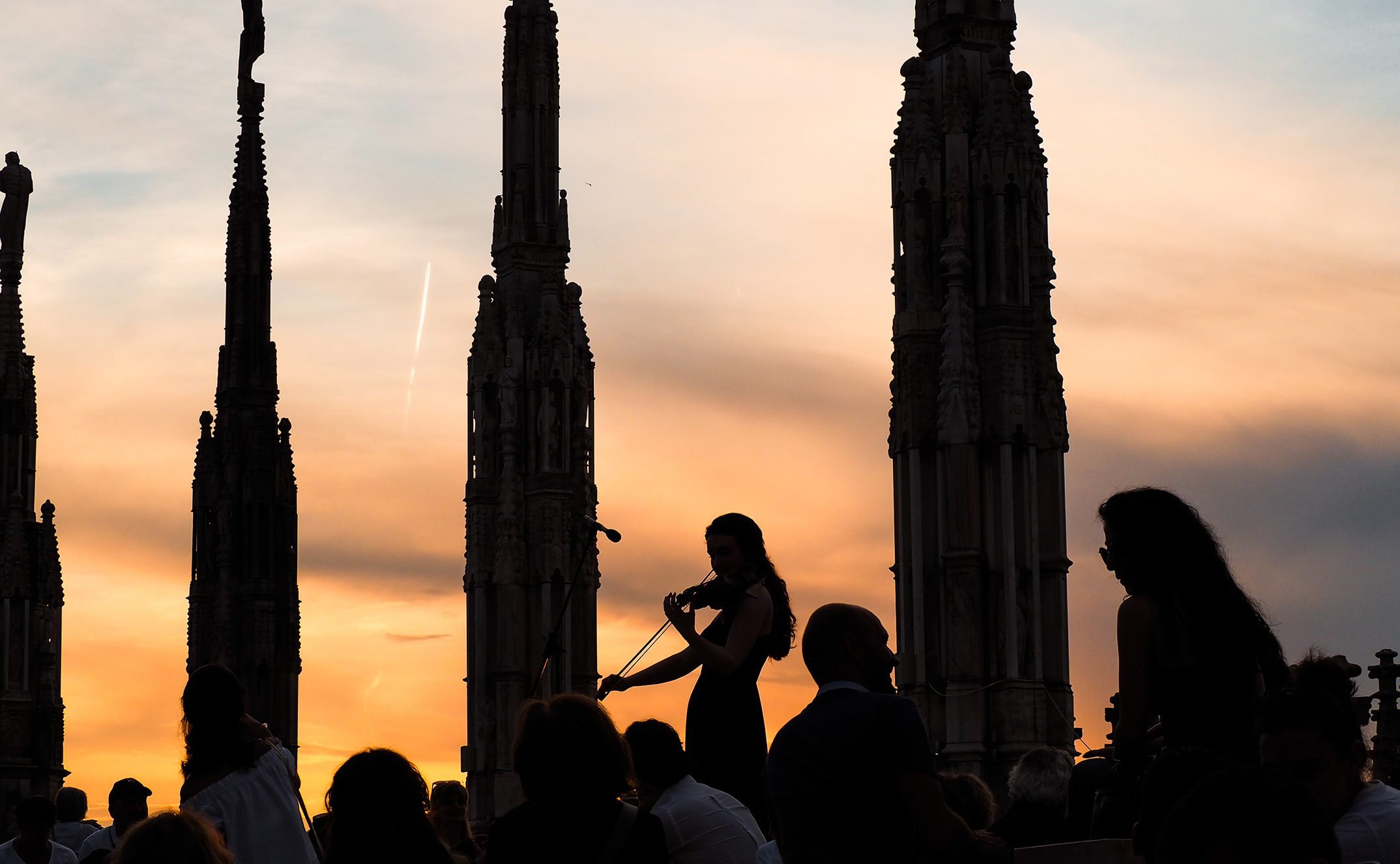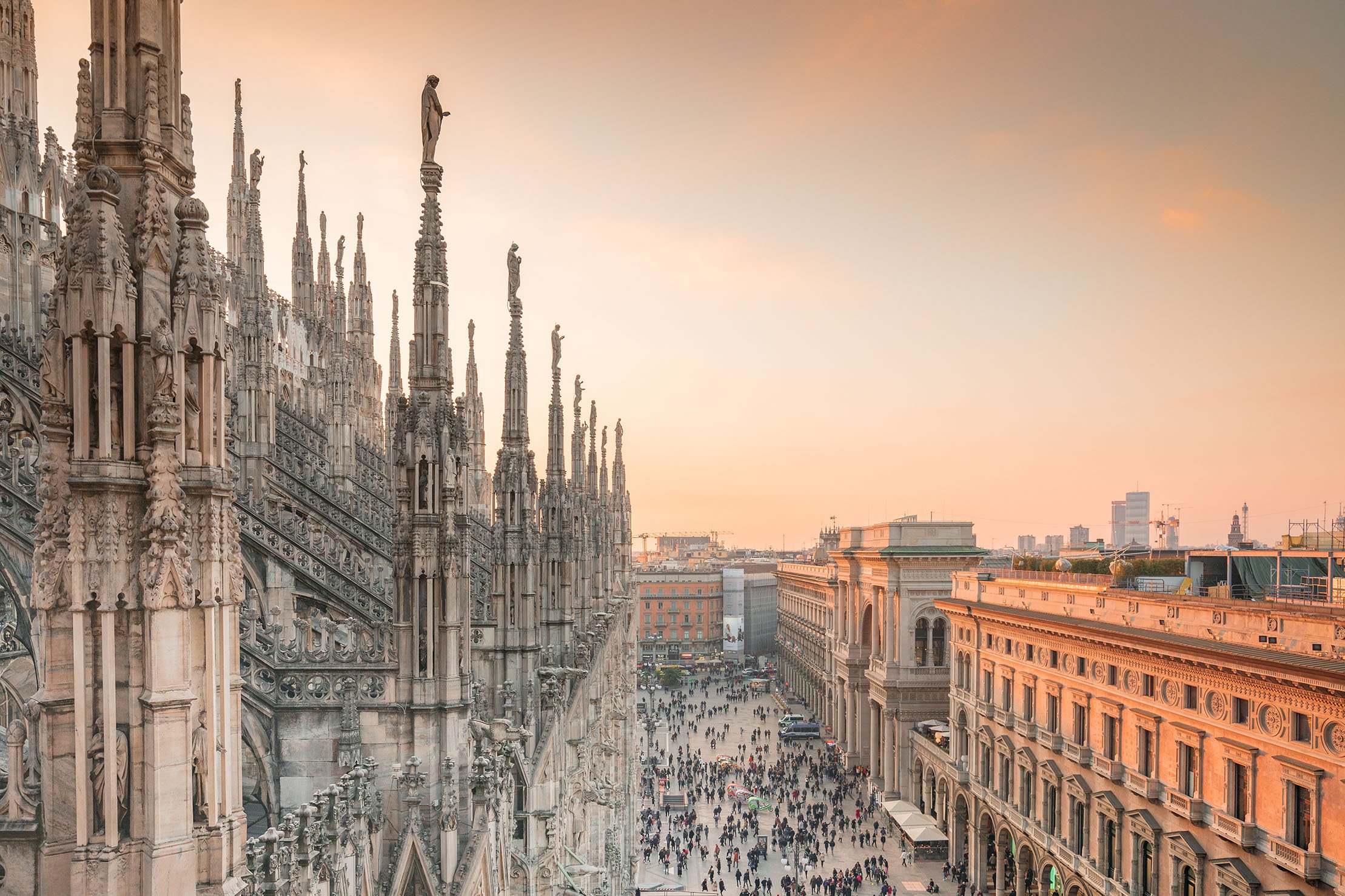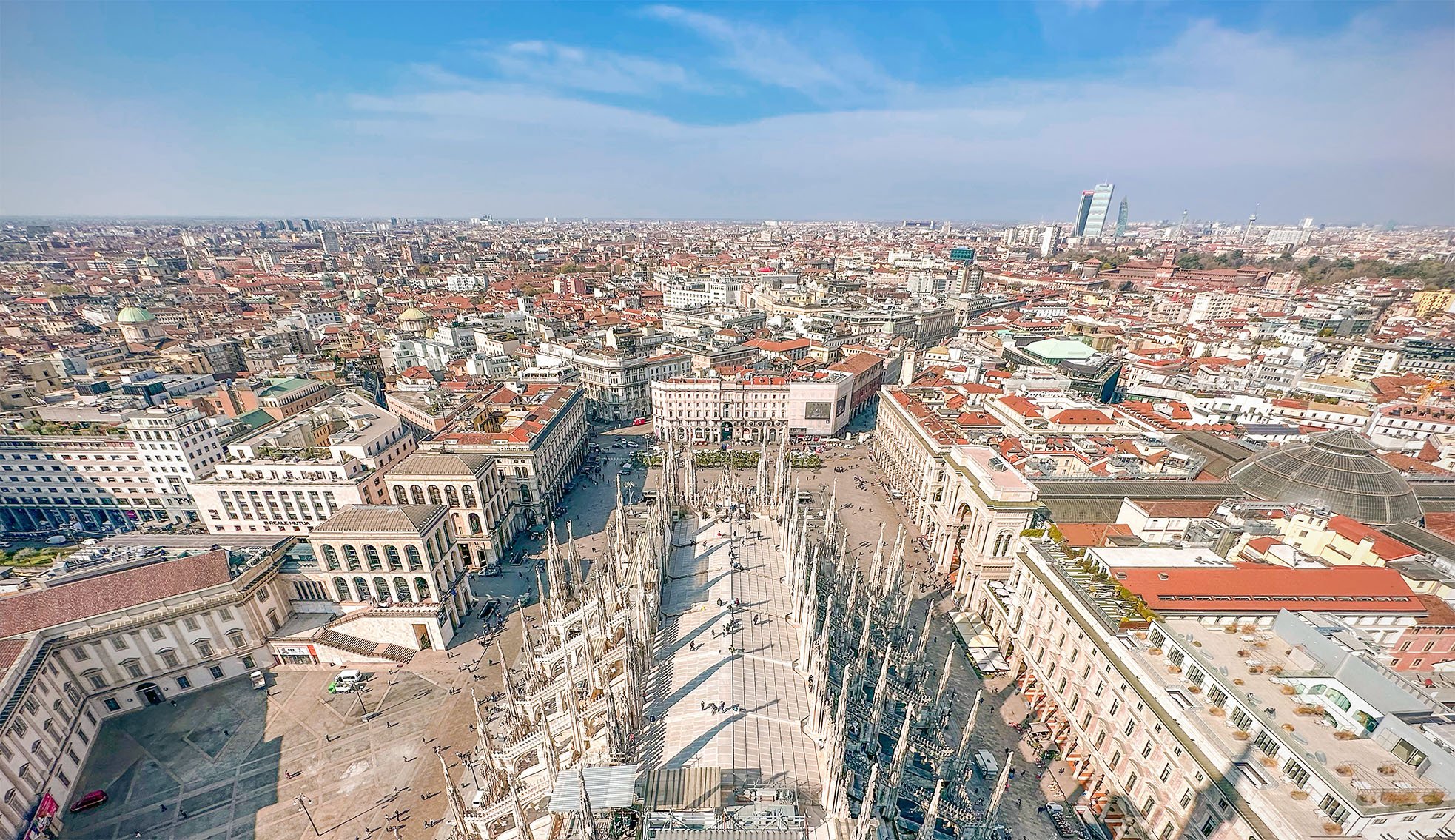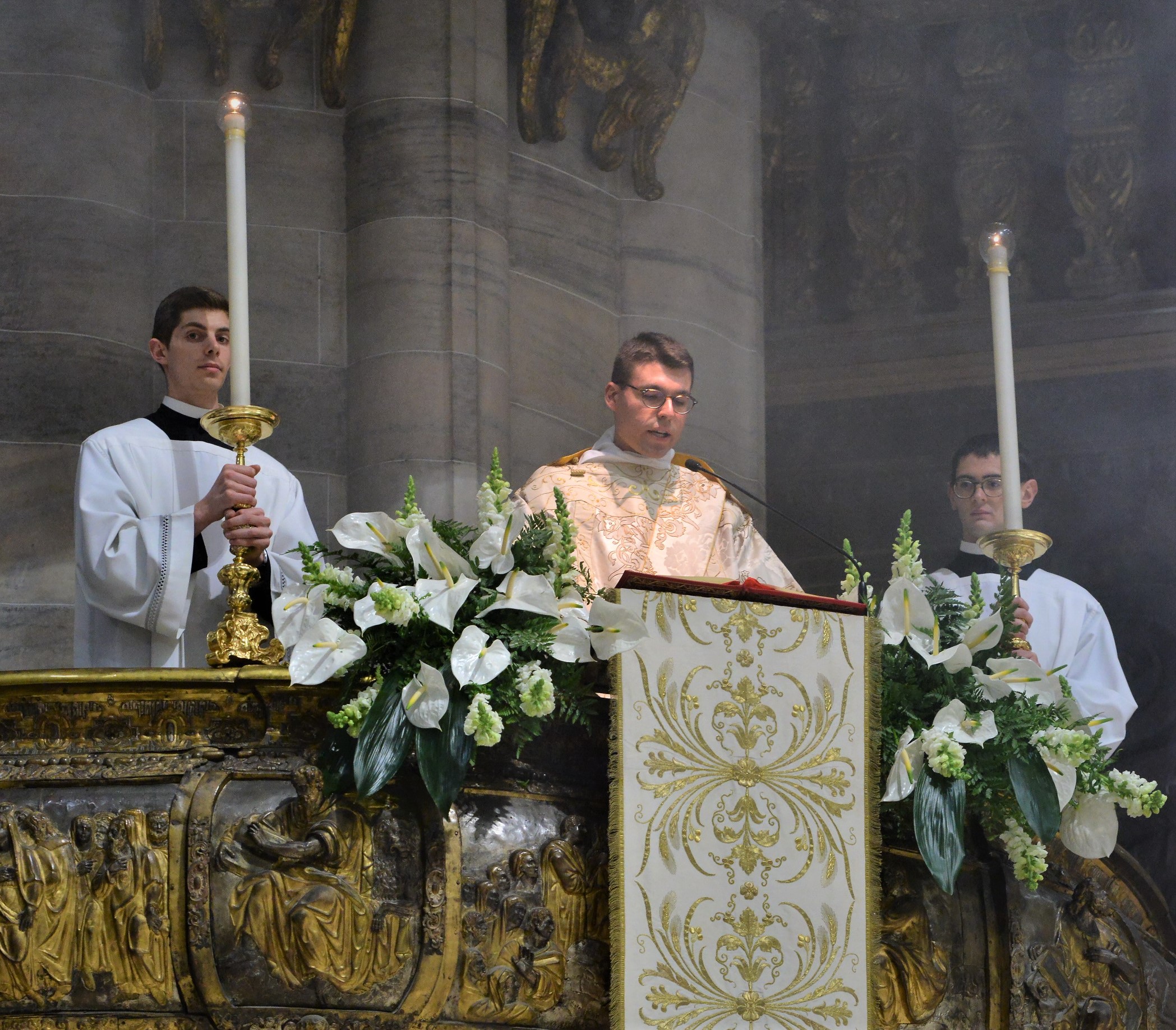La solenne Veglia pasquale
«Questa notte dobbiamo attendere in veglia che il nostro Salvatore risorga»
La Veglia pasquale è la «madre di tutte le veglie» (sant’Agostino), perché in questa notte la Chiesa attende, vegliando, la risurrezione di Cristo e la celebra nei Sacramenti.
Questa celebrazione rappresenta il momento centrale del Triduo pasquale e dell’intero anno liturgico. Pur nella somiglianza con lo schema di Rito Romano, la Chiesa di Milano – e in modo particolare la liturgia del Duomo – ha mantenuto una serie di particolarità. Infatti, la Liturgia Ambrosiana ha riletto in modo singolare la parte lucernale della Veglia, prevede una propria catechesi biblica e ha conservato, similmente a quanto avviene per il Giovedì santo alla Messa «nella Cena del Signore», anche l’antico Canone eucaristico proprio di questa notte.
La Veglia pasquale si apre con la liturgia della luce: infatti dal giorno precedente, in segno di lutto, tutti le lampade sono state spente. All’ingresso del Duomo, viene benedetto un lume – un tempo proveniente dalla vicina chiesa di San Sepolcro, memoria milanese dei luoghi santi della Passione del Signore – e mentre la processione si porta all’altare si compie una prima illuminazione del Duomo.
Dal pulpito, viene quindi intonato il Preconio (l’«Exúltet», dall’incipit del testo latino cantato dal diacono), un antico inno liturgico che, nella redazione tipica della tradizione ambrosiana (caratterizzato anche da una propria melodia), risale al V secolo. Il Preconio, nel quale le diverse immagini dell’agnello, del pastore, dell’acqua e del pane trovano la loro perfetta realizzazione in Gesù risorto da morte, rappresenta in un certo modo la “sintesi” dell’intera celebrazione. Il testo ambrosiano, interpretando in modo unico l’immagine della luce che proviene dal Cero (paragonato alla «colonna di fuoco» dell’Esodo e alla «stella» guida dei Magi), descrive la notte di Pasqua come quella in cui «si avverano preannunci e fatti profetici di vari millenni» e presenta i Sacramenti come segno di partecipazione alla Pasqua del Signore. Durante il canto del Preconio («Ecce iam ignis colúmna respléndet…»), l’Arcivescovo attinge alla fiamma del lume benedetto e accende il grande Cero pasquale, posto a fianco dell’ambone, e in diversi momenti legati al testo dell’Inno viene completata la progressiva accensione delle luci del Duomo e dei lumi dell’altare.
Fin dal suo inizio, la celebrazione risulta caratterizzata da una particolare tensione spirituale verso l’incontro con il Signore risorto: «Questa notte – canta ancora l’Exúltet – dobbiamo attendere in veglia che il nostro Salvatore risorga. Teniamo dunque le fiaccole accese come fecero le vergini prudenti; l’indugio potrebbe attardare l’incontro col Signore che viene. Certamente verrà e in un batter di ciglio, come il lampo improvviso che guizza da un estremo all’altro del cielo».
Segue la lunga catechesi biblica, composta da nove Letture, tratte dai due Testamenti, in cui sono ripercorsi tutti i momenti fondamentali della Storia della salvezza, partendo dalla creazione fino alla risurrezione ed esaltazione di Cristo. Terminate le sei Letture del Primo Testamento, risuona il solenne Annuncio della Risurrezione. L’Arcivescovo, con la mitra in capo e il pastorale, dai tre lati dell’altare, canta «Christus Dóminus resurréxit!» (Cristo Signore è risorto) e subito si suonano lo campane – che erano rimaste “legate” al momento dell’annuncio della morte del Signore – e l’organo, in segno di festa. Non il canto del Gloria quindi, come avviene nella corrispondente celebrazione di Rito Romano, ma il triplice Annuncio della Risurrezione segna il culmine della Veglia pasquale ambrosiana. Una particolarità, che presenta un forte parallelismo con la liturgia bizantina, mutuata da un’antichissima tradizione in uso a Gerusalemme, già nel V e VI secolo.
La terza parte della Veglia comprende l’amministrazione dei Sacramenti dell’Iniziazione cristiana (Battesimo, Confermazione, Eucaristia). Ogni anno, in Duomo, alcuni Catecumeni adulti ricevono dall’Arcivescovo i Sacramenti proprio in questa notte e sono rivestititi della veste bianca, segno della nuova vita di grazia, che scaturisce dalla rigenerazione battesimale. Quasi a rendere visibile l’immagine – richiamata dal Preconio – della «colonna di fuoco che risplende e guida i redenti alle acque che danno salvezza», la processione dei Catecumeni al Fonte battesimale di epoca borromaica, posto all’ingresso del Duomo, è guidata proprio del Cero pasquale.
Con la liturgia eucaristica si conclude e si compie la celebrazione della Veglia pasquale. Le parole del canto allo spezzare del pane (composto da san Giovanni Damasceno: 650c-750c) riassumono bene il senso della nostra partecipazione alla Pasqua del Signore Gesù: «Morivo con te sulla croce, oggi con te rivivo. Con te dividevo la tomba, oggi con te risorgo. Donami la gioia del regno, Cristo, mio Salvatore. Alleluia, alleluia».



